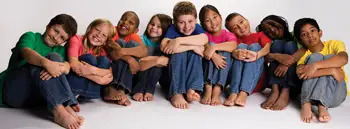Schools may teach the value of acceptance during Black History Month, but it is our duty as parents to instill an unbiased mindset in our children all the time. Here, some thoughts on why teaching tolerance is important, and tips for handling the awkward moments.

You are waiting in line at a department store. Your kindergartner spots a person nearby using a walker. Quite innocently yet inquisitively, the child asks you within hearing distance of others why that person “walks funny.”
Situations such as these are common. Children are naturally curious about anybody who looks or acts “different” from what they are used to. This could involve people who are disabled, who belong to another ethnicity, race, or religion, or people who have different viewpoints. The list goes on. Diversity is the norm in our world today, a world that is getting smaller, so to speak, thanks to advances in technology and infinite opportunities for travel.
Children inevitably will come into contact with those who could be construed as “different” from them. It is therefore important for parents to have tools at the ready to help their children navigate the often-tricky waters of learning tolerance. Experts agree that teaching tolerance is integral to a child’s success in education and beyond.
Setting the Right Tone
The main ingredient here for parents is teaching by example. “Parents who practice discrimination pass it on to their kids,” says Los Angeles-based diversity consultant Sahar Andrade. “This can lead to problems with a child’s learning process. For example, if a child has absorbed certain negative attitudes about people of a certain race or ethnicity and someone of that group is his or her teacher, the child might well be hostile toward the teacher and, consequently, not absorb the lessons taught in class.” She adds, “Every child learns by example. Early childhood and family experiences shape attitudes.”
It’s never too early to begin teaching a child the merits of tolerance. Robin Ordan, LMT, LCSW, a Stamford, Connecticut-based social worker who is also the lower school counselor at Stamford’s King Low Heywood Thomas School says, “I believe teaching tolerance should begin from age 0 on. Kids absorb what parents teach them from day one until they are older. The majority of teaching isn’t done overtly, but in more offhand ways. Children see who their parents’ friends are. Or, they may overhear their parents making derogatory comments about somebody’s weight or religion. Many parents are not conscious of the messages they convey.”
Kate Vivanco, EdM, LCSW, cites some examples. “Parents can be unaware that they are sending certain messages to children concerning diversity. For example, always demonstrating a ‘white’ preference when choosing a doll that is available in multiple skin tones, such as Barbie, can send a message to the child that a white skin tone is preferable. I encourage parents to take a look around at the toys, books, and movies in the home and to think about whether or not they promote an interest in different cultures and a preference for diversity. I would suggest that families read books together on different cultures and encourage conversations about culture, race, and differences.”
Andrade notes in one of many articles she has written on the topic that it is helpful and fun to involve children in different cultural festivities to further offer an understanding of diversity. She says that an open dialogue with children is key to helping them keep open minds on the topic of differences. She adds that it is advisable for parents to candidly and honestly address questions their kids may have. An unwillingness to participate in a discussion is a signal to a child that something is wrong with those who possess differences.
Instilling Empathy
Ordan’s capacity as a school counselor includes working with pre-K through fifth graders on the topics of tolerance and diversity. “We use two curricula for the kindergarten through fifth grader s- a workbook and an interactive program,” she says. “The kids discuss certain subjects as part of this, stereotyping being one. They learn that everyone has their strengths and challenges. It’s inspiring to see the children self-monitor and encourage each other to be supportive of others.”
She makes a point that addresses the department store scenario mentioned above: “If a child makes an off-putting comment in public concerning another person who looks or acts differently, it is a teachable moment for the parent,” Ordan explains. “I would suggest for the parent to quietly pull the child aside and address the comment, depending on how the child directed it. For example, if the person the child commented about was handicapped or overweight, the parent can ask the child how he or she would feel being in the other person’s shoes and the target of certain comments. It’s about creating compassion and empathy for others in order for the child to be self-reflective.” She adds, “If the other person hears the child’s comment, in that case it might be in order for the parent to direct the child to own up to this mistake and apologize to the person.”
Danielle Sullivan, a Brooklyn mom of three children ages 18, 13, and 7, believes that empathy is a key component to instill in this process. “A child who is being made fun of is probably suffering, and I would encourage my child to reach out in some way – maybe by offering to play together or sit together at lunch. It is our duty as parents to teach our kids to be good to one another, and we must model that for our kids as well. Like Gandhi said, we have to be the change we want to see.”
Another mom of three, Bernadette Montalvo of Long Island, offers her take on the subject. Teaching tolerance is a high priority in her family, which includes kids ages 1, 5, and 9. “Today’s children are our future, and we need to direct them to be great leaders. To do this, they need to learn to work with one another.” Montalvo offers some insight, as well, based on her own personal experience: “My husband is Hispanic, and so my kids need to learn first-hand tolerance of others. Even though they are being raised American, they have relatives who speak Spanish. At first, this was odd to them, but I explained that not everyone is like them. People speak other languages, are different colors, sizes, shapes, etc. I believe that if you don’t make an issue out of one’s differences, kids won’t either.”
Of course, teaching tolerance does not mean teaching children to tolerate aberrant behavior such as bullying or maliciousness. Those actions are not in keeping with the true spirit of tolerance, which is acceptance of people who are different and treating them with kindness. It is important to remember that just as intolerance is learned, so is tolerance. To again quote Gandhi, “We have to be the change we want to see” to help that along for the next generation.
Also see: Books that Teach Children About Diversity and Tolerance
How to Raise a Generous and Appreciative Child





















